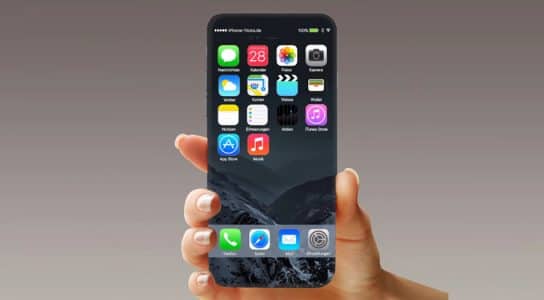iPhone 8 will see OLED glass screens and augmented reality - Dispatch Weekly
March 7, 2017 - Reading time: 7 minutes

This summer marks the 10 year anniversary of the Apple iPhone’s first launch. Revolutionising the industry, Apple is now the leading brand for smartphones and laptops. If predictions and speculation about the iPhone 8 are true, Apple will once again change the game.
The newly improved iPhone 8, being released this September, builds upon the iPhone 7’s improvements on fusion chips, waterproof features, and curved designs. The latest model is predicted to surpass industry standards with an all-glass design, and feature augmented reality.
Design
In March 2016, Samsung Display and Apple Inc. reportedly signed a contract making Samsung the new supplier of Apple’s OLED screens. This marks a change in former product designs – moving away from current LCD screens towards glass display screens.
With the integration of OLED screens, and a previously expressed desire from Senior Vice President of design, Jony Ive, the iPhone 8 is expected to be a step forward to full glass display model. This allows Apple to create slimmer phones, increase image quality and colour integration, reduce environmental footprint, and reduce bezel size, which if removed completely, will increase screen size to 5.8 inches – making it the biggest smartphone screen available.
What can we expect?
This, paired with a patent taken out for fingerprint ID recognition, hints the iPhone 8 may ditch the home button, replacing it with an integrated fingerprint ID scanner and increased touch response. Integrating sensory technology into the iPhone could mean an exciting era of sensitive smartphone, allowing for more screen utilisation such as being able to capture pictures by simply tapping the screen.
 Image source: 9to5mac
Image source: 9to5mac
KGI securities analyst, Ming-Chi Kuo, who has successfully and consistently predicted Apple’s designs before, has speculated about the implications of the Apple OLED screen and home button replacement. Kuo believes that following the example of their newly released 2017 Macbook Pro, the iPhone 8 will feature a touchscreen bar along with the increased screen size and home button replacement.
Specs
Following their advancement to quad-core chips in the iPhone 7, Apple is expected to have an A11 fusion chip in the iPhone 8. This will allow for a faster and increasingly efficient mobile device, which when paired with the OLED display means longer battery life.
With one of the biggest customer complaints being their short battery life, a newly improved design accommodating for increased efficiency and battery life will boost Apple’s smartphone performances and take their products to the next level.
The Wall Street Journal reports that Apple is looking to include the bendable LCD technology seen in current smartphones like the Samsung Galaxy S7 into their future phones. This would seem to indicate that the iPhone 8 will, to some degree, be bendable. Pair this with the expected improvements in the waterproof features of the iPhone 7, the iPhone 8 could prove to be a newly resistant smartphone.
 Speculations on the phone’s improved specs also include a switch to the universal USB-C charging port in place of the current lighting model. Some even say that Apple is working on a wireless charging feature that could extend up to 15ft.
Speculations on the phone’s improved specs also include a switch to the universal USB-C charging port in place of the current lighting model. Some even say that Apple is working on a wireless charging feature that could extend up to 15ft.
Smartphones with augmented reality
Though the design and spec improvements are already very impressive, the most exciting feature of the iPhone 8 comes with Apple’s desire to integrate augmented reality into their products. Apple Inc’s CEO, Tom Cook, has made it clear in the past that he believes AR is the future of technology and smartphones. Now Apple seems to have made it its mission to include said features in its future phones. With already 1000 employees working on developing augmented reality technology, industry specialists and analysts believe that:
the iPhone 8 will indeed have AR features integrated, marking a significant step-up in innovation and smartphone development.
Currently, Apple is believed to be working on including 3D sensing technology and facial recognition into the iPhone 8. A KGI report states that the iPhone 8 will include a revolutionary 3D camera able to sense the space around it, and identify and recognise objects, allowing the phone to be able to “see” it’s surroundings. This will enhance user experience and allow for features such as facial recognition technology to create 3D selfies.
The iPhone 8 is expected to be released in September 2017.

DW Staff
David Lintott is the Editor-in-Chief, leading our team of talented freelance journalists. He specializes in covering culture, sport, and society. Originally from the decaying seaside town of Eastbourne, he attributes his insightful world-weariness to his roots in this unique setting.




